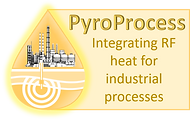PyroPetrol - Improving Oil Extraction, Transportation & Refining
Delivering solutions to efficiently extract heavy crude, prevent paraffin accumulation, and upgrade low quality fossil fuels

A New Approach to Securing Energy Independence
Not all oil and gas deposits are easily recoverable. As society consumes energy every day, the “low hanging fruit” resources have been depleted first, meaning the remaining reservoirs are of lower quality and increasingly difficult to extract. While fracking unlocked vast oil resources, it left behind a legacy of failed companies, flared methane and rapid resource depletion. Meanwhile heavy oil deposits have extremely low depletion rates but are difficult to produce.
PyroWax
Delivering heat to existing wells that need it
After commissioning an oil or gas well, significant, and/or unexpected challenges may arise, which require mechanical scraping, chemicals, or heat to mitigate. These can be changes in the properties of the oil (viscosity, density, composition), or changing temperature conditions of the subterrestrial/sub oceanic environment usually due to decreased production or EOR techniques such as gas lift. Furthermore, Paraffin, Iso-paraffins, Aromatics, Naphthenes, Olefins (PIANO) or Hydrates in the case of gas wells have been a thorn in the side for deep sea and artic wellbores for many years, since precipitation and accumulation on well surfaces starts at 30°C. PIANO/Hydrate accumulation is mitigated by maintaining the temperature from the bottom hole to the surface
above 30°C or scraping jobs (which impacts production), hot oiling (costs production) or chemical injection (expensive and not always effective). Slowing/stopping of flow rates for a variety of reasons, make maintaining temperatures above 30°C is impossible, and if heat is not immediately delivered downhole, or if flow does not promptly resume, the well may become completely blocked.


PyroWax represents a paradigm shift for advanced resource recovery since it utilizes preexisting piping, casing, or tubing in the wellbore to deliver targeted, precise and variable heat. A force loaded heater connector forms electrical connection while allowing PyroWax pipe to be inserted and slide down the wellbore. This solution can not only recover a permanently inoperable well due to PIANO/Hydrate blockages, but can be left intact, delivering heat during operations eliminating temperature dependent risks The PyroHeater provides RF skin effect heating to targeted locations. PyroWax ideal for dynamic and demanding production environments. Multiple RF generators can be added in parallel to increase total heat output and the heater connector does not restrict fluid flow, and the use of coiled tubing allows the heat position to be varied in real time
For gas lift wells, the PyroWax solution is to utilize insulated capillary tubing inside the production tubing. A downhole device completes the circuit at the optimum depth where the product is cooling during its way to the surface. From the surface down to that point, the PyroHeater system is delivering uniform temperature to the capillary tubing and production tubing walls since they are the conductors for the circuit (see PyroHeater). For rod lift wells, the PyroWax solution utilizes coated rod as the inner conductor and the production tubing as the outer conductor, heating the production tubing and eliminating wax, asphaltene and hydrate deposits, while reducing the viscosity of the produced fluid, helping your pumping.

PyroWell
An engineered solution for extracting challenging, viscous & heavy resources

There is abundant energy stored in reservoirs throughout the United States and Canada, however these resources require intensive heat for extraction. The industry needs an alternative to providing heat down to challenging pay zones, and PyroWell is a robust process that delivers precision heating from PyroHeater technology. Used in either a single well or multiple hole configuration (similar to Steam Assist Gravity Drainage [SAGD]), the PyroHeater changes the paradigm of thermal resource treatment and can deliver a more focused heat pattern than steam or hot water flood, but can also be utilized in concert with these techniques.
Unlike conventional, production fluid in-line electrical heaters, the PyroWell takes advantage of skin-effect resistance direct heating of the production tubing and recovery casing. Hooking up the RF
generator on the surface, the casing can reach up to 760°C, and that heat permeates out into the resource reservoir. This direct method of heating solves all challenges common to challenging pay zones without any external equipment or processes. paraffins are liquified, solids solubilize, and the viscosity decreases, causing the resource to freely flow into the PyroWell and extracted to the surface.
PyroUpgrader
Upgrading the quality, and transportation properties of low-grade fossil fuels
Much of North America’s new energy resources is in low quality bitumen oil sands. For example, Alberta’s Athabasca oil sands is the 3rd largest oil reserve in the world, with 166 billion barrels of commercially established oil reserves distributed over 55,000 sq mi – an area larger than England.
Bitumen is a low-quality oil with an API of 8-12 (200+ Carbons), which gives it a high density (~1 SG), molecular weight (~600-1500), viscosity (~50k-100k cp) and sulfur content (3-5 wt%). After extraction, the bitumen is diluted (~33 vol% naphtha), reducing the viscosity enough for pipeline transportation, adding $3-5/barrel in logistics cost. Due to the magnitude of large components like asphaltenes (~15%), the first refining step utilizes delayed cokers (~500°C & ~3 atm), reducing the molecular weight suitable for distillation/fractionation. Delayed cokers are massive surface vessels (~30 ft diameter, ~120 ft tall) representing 1 billion+ in capital each, and due to semi batch operations and challenges with clearing solid coke, delayed cokers come in pairs.
Supercritical water will decrease the density, viscosity, and molecular weight of the lowest quality fossil fuels, eliminating the diluent requirement and the need for expanded delayed coking capacity. Under these conditions, non-soluble large and complex

hydrocarbons start to dissolve and are broken down into radicals and smaller hydrocarbons. Supercritical water has a caging effect, dispersing dissolved hydrocarbon intermediates to restrict out of control char/coke forming polymerization. While supercritical water can dissolve generally insoluble molecules, it precipitates undesirable metallic components (Vanadium, Sulfur) which become encapsulated while char/coke (albeit limited) is forming, thus preventing reincorporation into the oil matrix. Finally, hydrogen is donated from water and other dissolved molecules, increasing the hydrogen:carbon ratio, improving energy and stability. For example, models predict that PyroUpgrading bitumen has a 85-95% yield and produces < 5% char/coke – compared to 20-30% from delayed cokers. The API increases to ~25-35, and removes ~75% of the sulfur content, allowing bitumen to command a similar price structure to Western Texas Intermediate (WTI), which is ~$15-$30/bbl more.
The PyroUpgrader utilizes the PyroReactor and PyroHeater technologies to facilitate supercritical water upgrading with a low risk, effective, and scalable approach. Beyond the favorable capital costs of leveraging oil well technology, the unique dynamics of 1000’s of feet of flow within the reactor leverage the laws of physics to maximize efficiency, rather than expending energy and capital fighting them
-
Supplementary hydrostatic pressure, reduces energy input and mitigates pumping challenges of viscous high solids feeds at high flow rates
-
The long heat-transfer regions provide efficient heat exchange, eliminating expensive, complex, and custom heat exchangers
-
Gradual temperature/pressure changes along with flow induced mixing, aids homogeneity delivering useful reactor dynamics
-
Subsurface land is an excellent insulator with natural geothermal gradients
The PyroUpgrader has a minimal surface footprint, where reactor volumes capable of producing 1000-5000 bbl/day are achieved with a deep, small diameter vessel. This makes it ideal for modularly integrating the same proven and relatively inexpensive design, at extraction sites to eliminate diluent/transportation costs and scaling risks.

PyroArray
Volumetric heating of shallow payzones

Under Development
Some resources are shallow but rich, such as the oil sands in Canada and Utah. For those heavy oil deposits, a volumetric heating approach such as the PyroArray may be the best fit. Similar to how a microwave oven works, an array of RF electrodes are emplaced underground to dielectrically heat the hydrocarbon rich formation. This technology can also be deployed for PyroRemediation of toxic spills such as solvents and as part of our PyroDefense offering









